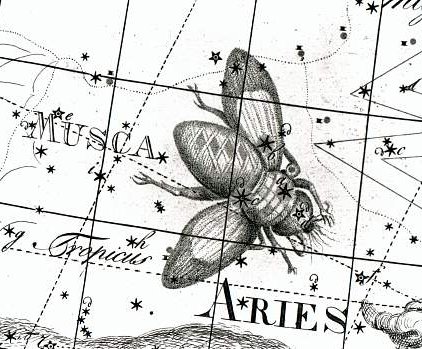7. There is an earlier puo in the G text, in connection with Musca (see at Botein):
From Bharani (a star ruled by Venus) to the end of the back side (Gb8-29) there are 22 (= 7 * π) glyphs:
The 'spirit fly' which appears to have emerged from the head of Medusa could go down into Mother Earth and if so then it needs to be dug up to get vitality back:  If we try to correlate the days of the year with the glyphs in G we can guess winter solstice should be at the head of Medusa (Algol at Gb8-12) which is 4 days after the puo glyph:
Adding 64 (= 8 * 8) to the glyph number for puo (450) results in what may be a symbolic value (200 more than 314). Perhaps at number 514 (= 5 and 14) all fires should be finished (hilled up with a cover of earth). Claude Lévi-Strauss in his From Honey to Ashes: "In China, every year about the beginning of April, certain officials called Sz'hüen used of old to go about the country armed with wooden clappers. Their business was to summon the people and command them to put out every fire. This was the beginning of the season called Han-shih-tsieh, or 'eating of cold food'. For three days all household fires remained extinct as a preparation for the solemn renewal of the fire, which took place on the fifth or sixth day after the winter solstice. The ceremony was performed with great pomp by the same officials who procured the new fire from heaven by reflecting the sun's rays either from a metal mirror or from a crystal on dry moss. Fire thus obtained is called by the Chinese heavenly fire and its use is enjoined in sacrifices: whereas fire elicited by the friction of wood is termed by them earthly fire, and its use is prescribed for cooking and other domestic purposes ... Like archaic China and certain Amero-Indian societies, Europe, until quite recently, celebrated a rite involving the extinguishing and renewal of domestic fires, preceded by fasting and the use of the instruments of darkness. This series of events took place just before Easter, so that the 'darkness' which prevailed in the church during the service of the same name (Tenebrae), could symbolize both the extinguishing of domestic fires and the darkness which covered the earth at the moment of Christ's death. In all Catholic countries it was customary to extinguish the lights in the churches on Easter Eve and then make a new fire sometimes with flint or with the help of a burning-glass. Frazer brings together numerous instances which show that this fire was used to give every house new fire. He quotes a sixteenth-century Latin poem in a contemporary English translation, from which I take the following significant lines: On Easter Eve the fire all is quencht in every place, // And fresh againe from out the flint is fecht with solemne grace. Then Clappers cease, and belles are set againe at libertée, // And herewithall the hungrie times of fasting ended bée ..." If we count 'five or six days' ahead, beyond Algol, we arrive at the elbow of Perseus (Algenib in Gb8-17):
This is a day of Venus and surely we can see a new generation. The ure sign in front is bent like a concave mirror in the opposite direction to how henua in Gb8-13 is bent. The central symmetric figure in the 3 days between has a 'head' which announces 'no light' or 'no feeding' - the hands (rima) are oriented outwards instead of inwards, they are empty. The use of wooden clappers comes at the end of the old year and the quijada is another rattling instrument. The opposite is the bell type of instrument (as in the left hand of Vajrasattva). Lévi-Strauss: "... The reader will no doubt have noticed that a curious analogy exists between the means employed for the tapped-out call in the South American myths: a resonator made from a gourd of tree-trunk which is struck, sticks which are knocked against each other, or clappers, and a liturgical complex belonging to the Old World, known as the instruments of darkness. The origin of these instruments, and their use from the Thursday to the Saturday of Holy Week, presents a great many problems. As I cannot claim to participate in a complex discussion which lies outside my competence, I shall merely refer to one or two generally accepted points. It would seem that fixed bells in churches did not make their appearance until rather late, about the seventh century. Their enforced silence from the Thursday to the Saturday of Holy Week does not seem to be recorded before about the eighth century (and then only in Rome). At the end of the twelfth and beginning of the thirteenth century, the restriction appears to have spread to other European countries. But the reason for the bells remaining silent, and for them being replaced temporarily by other sources of noise, is not clear. Their alleged journey to Rome, which accounted for their temporary absence, may be no more than an a posteriori explanation, founded moreover on all kinds of beliefs and imaginative suppositions connected with bells: they were thought to be animate, vocal beings, capabe of feeling and acting, and fit for baptism. In addition to summoning the congregation to the church, bells had a meteorological, and even a cosmic, function. Their reverberations drove storms away, dispelled clouds and hail, and destroyed evil spells ..." |
||||||||||||||||||||||||||||||||||||||||||||||||||||||||||||||||||||||||||||







